Understanding the Effects of Parameter Uncertainty on Temporal Dynamics of Groundwater-Surface Water Interaction
Abstract
:1. Introduction
2. Study Area
3. Materials and Methods
3.1. GW-SW Interaction Modeling
3.2. Generation of Case Scenarios
3.3. Sensitivity Analysis of GW-SW Interaction
3.4. Uncertainty Analysis of GW-SW Interaction
4. Results and Discussion
4.1. Uncertainty Analysis of GW-SW Interaction under the A2 Scenario
4.2. Uncertainty Analysis of GW-SW Interaction under the B1 Scenario
4.3. Comparison of Uncertainty Analysis of GW-SW Interaction between the A2 and B1 Scenarios
5. Conclusions
Acknowledgments
Author Contributions
Conflicts of Interest
References
- Kalbus, E.; Reinstorf, F.; Schirmer, M. Measuring methods for groundwater-surface water interactions: A review. Hydrol. Earth Syst. Sci. 2006, 10, 873–887. [Google Scholar] [CrossRef]
- Sophocleous, M. Interactions between groundwater and surface water: The state of the science. Hydrogeol. J. 2002, 10, 52–67. [Google Scholar] [CrossRef]
- Scibek, J.; Allen, D.M. Modeled impacts of predicted climate change on recharge and groundwater levels. Water Resour. Res. 2006, 42, W11405. [Google Scholar] [CrossRef]
- Van Roosmalen, L.; Christensen, B.S.B.; Sonnenborg, T.O. Regional differences in climate change impacts on groundwater and stream discharge in Denmark. Vadose Zone J. 2007, 6, 554–571. [Google Scholar] [CrossRef]
- Goderniaux, P. Impact of climate change on groundwater reserves. Ph.D. Thesis, University of Liege, Liège, Belgium, 2010. [Google Scholar]
- Stoll, S.; Hendricks Franssen, H.J.H.; Butts, M.; Kinzelbach, W. Analysis of the impact of climate change on groundwater related hydrological fluxes: A multi-model approach including different downscaling methods. Hydrol. Earth Syst. Sci. 2011, 15, 21–38. [Google Scholar] [CrossRef]
- Jackson, C.R.; Meister, R.; Prudhomme, C. Modeling the effects of climate change and its uncertainty on UK Chalk groundwater resources from an ensemble of global climate model projections. J. Hydrol. 2011, 399, 12–28. [Google Scholar] [CrossRef]
- Vansteenkiste, T.; Tavakoli, M.; Ntegeka, V.; Willems, P.; De Smedt, F; Batelaan, O. Climate change impact on river flows and catchment hydrology: A comparison of two spatially distributed models. Hydrol. Process. 2012. [Google Scholar] [CrossRef]
- El Hassan, A.A.; Sharif, H.O.; Jackson, T.; Chintalapudi, S. Performance of a conceptual and physically based model in simulating the response of a semi-urbanized watershed in San Antonio, Texas. Hydrol. Process. 2013, 27, 3394–3408. [Google Scholar] [CrossRef]
- Wu, B.; Zheng, Y.; Tian, Y.; Wu, X.; Yao, Y.; Han, F.; Liu, J.; Zheng, C. Systematic assessment of the uncertainty in integrated surface water-groundwater modeling based on the probabilistic collocation method. Water Resour. Res. 2014, 50, 5848–5865. [Google Scholar] [CrossRef]
- Faramarzi, M.; Abbaspour, K.C.; Adamowicz, W.L.; Lu, W.; Fennell, J.; Zehnder, A.J.B.; Goss, G.G. Uncertainty based assessment of dynamic freshwater scarcity in semi-arid watersheds of Alberta, Canada. J. Hydrol. Reg. Stud. 2017, 9, 48–68. [Google Scholar] [CrossRef]
- Benke, K.K.; Lowell, K.E.; Hamilton, A.J. Parameter uncertainty, sensitivity analysis and prediction error in a water-balance hydrological model. Math. Comput. Model. 2008, 47, 1134–1149. [Google Scholar] [CrossRef]
- Muleta, M.K.; Nicklow, J.W. Sensitivity and uncertainty analysis coupled with automatic calibration for a distributed watershed model. J. Hydrol. 2004, 306, 127–145. [Google Scholar] [CrossRef]
- Beven, K.J.; Binley, A.M. The future of distributed models: Model calibration and uncertainty prediction. Hydrol. Process. 1992, 6, 279–298. [Google Scholar] [CrossRef]
- Kuczera, G.; Mroczkowski, M. Assessment of hydrological parameter uncertainty and the worth of multiresponse data. Water Resour. Res. 1998, 34, 1481–1489. [Google Scholar] [CrossRef]
- Vrugt, J.A.; Gupta, H.V.; Bouten, W.; Sorooshian, S. A Shuffled Complex Evolution Metropolis algorithm for optimization and uncertainty assessment of hydrologic model parameters. Water Resour. Res. 2003, 39, 1201. [Google Scholar] [CrossRef]
- Mishra, S. Uncertainty and sensitivity analysis techniques for hydrologic modeling. J. Hydroinform. 2009, 11, 282–296. [Google Scholar] [CrossRef]
- Shen, Z.Y.; Chen, L.; Chen, T. Analysis of parameter uncertainty in hydrological and sediment modeling using GLUE method: A case study of SWAT model applied to Three Gorges Reservoir Region, China. Hydrol. Earth Syst. Sci. 2012, 16, 121–132. [Google Scholar] [CrossRef]
- Shen, Z.Y.; Chen, L.; Chen, T. The influence of parameter distribution uncertainty on hydrological and sediment modeling: A case study of SWAT model applied to the Daning watershed of the Three Gorges Reservoir Region, China. Stoch. Env. Res. Risk 2013, 27, 235–251. [Google Scholar]
- Fan, Y.R.; Huang, W.; Huang, G.H.; Huang, K.; Zhou, X. A PCM-based stochastic hydrological model for uncertainty quantification in watershed systems. Stoch. Env. Res. Risk 2015, 29, 915–927. [Google Scholar] [CrossRef]
- Fan, Y.R.; Huang, G.H.; Baetz, B.W.; Li, Y.P.; Huang, K.; Li, Z.; Chen, X.; Xiong, L.H. Parameter uncertainty and temporal dynamics of sensitivity for hydrologic models: A hybrid sequential data assimilation and probabilistic collocation method. Environ. Modell. Softw. 2016, 86, 30–49. [Google Scholar] [CrossRef]
- Wu, M.; Jansoon, P.; Tan, X.; Wu, J.; Huang, J. Constraining Parameter Uncertainty in Simulations of Water and Heat Dynamics in Seasonally Frozen Soil Using Limited Observed Data. Water 2016, 8, 64. [Google Scholar] [CrossRef]
- Naumburg, E.; Mata-Gonzalez, R.; Hunter, R.; Mclendon, T.; Martin, D. Phreatophytic vegetation and groundwater fluctuations: A review of current research and application of ecosystem response modeling with an emphasis on Great Basin vegetation. Environ. Manag. 2005, 35, 726–740. [Google Scholar] [CrossRef] [PubMed]
- Dobson Engineering Ltd.; Urban Systems Ltd. Kiskatinaw River Watershed Management Plan. 2003. File 0714.0046.01. Available online: http://www.dawsoncreek.ca/cityhall/departments/water/watershed/background-watershed-management-plans/ (accessed on 12 November 2016).
- Saha, G.C. Groundwater-surface water interaction under the effects of climate and land use changes. Ph.D. Thesis, University of Northern British Columbia, Prince George, BC, Canada, 2014. [Google Scholar]
- Saha, G.C.; Paul, S.S.; Li, J.; Hirshfield, F.; Sui, J. Investigation of land-use change and groundwater-surface water interaction in the Kiskatinaw River Watershed, British Columbia (parts of NTS 093P/01, /02, /07-/10) Report 2013-1. In Geoscience BC Summary of Activities 2012; Geoscience BC: Vancouver, BC, Canada, 2013; pp. 139–148. [Google Scholar]
- Ogden, F.L.; Saghafian, B. Green and ampt infiltration with redistribution. J. Irrig. Drain. Eng. 1997, 123, 386–393. [Google Scholar] [CrossRef]
- Downer, C.W. Identification and modeling of important stream flow producing processes in watersheds. Ph.D. Thesis, University of Connecticut, Storrs, USA, 2002. [Google Scholar]
- GeoBase. Available online: www.geobase.ca (accessed on 15 January 2016).
- Paul, S.S. Analysis of land use and land cover change in Kiskatinaw River watershed: A remote sensing, GIS & modeling approach. M.Sc. Thesis, University of Northern British Columbia, Prince George, BC, Canada, 2013. [Google Scholar]
- Land Resource Research Institute. Soils of Fort St. John-Dawson Creek, British Columbia. Soil Survey report No. 42; Agriculture Canada: Vancouver, BC, USA, 1985. [Google Scholar]
- Woldeamlak, S.T.; Batelaan, O.; De Smedt, F. Effects of climate change on the groundwater system in the Grote-Nete catchment, Belgium. Hydrogeol. J. 2007, 15, 891–901. [Google Scholar] [CrossRef]
- Solinst. Available online: www.solinst.com (accessed on 20 May 2014).
- McWhorter, D.B.; Sunada, D.K. Ground-water Hydrology and Hydraulics; Water Resources Publications: Fort Collins, Colorado, USA, 1977. [Google Scholar]
- Kala Groundwater Consulting Ltd. Groundwater potential evaluation Dawson Creek. British Columbia. Reference. 2001, R01332-0622. Available online: http://www.dawsoncreek.ca/wordpress/wpcontent/uploads/watershed/2001DCk_Kala_GWPotential.pdf (accessed on 18 July 2016).
- Santhi, C.; Arnold, J.G.; Williams, J.R.; Dugas, W.A.; Srinivasan, R.; Hauck, L.M. Validation of the SWAT model on a large river basin with point and nonpoint sources. J. Am. Water Resour. Assoc. 2001, 37, 1169–1188. [Google Scholar] [CrossRef]
- Van Liew, M.W.; Arnold, J.G.; Garbrecht, J.D. Hydrologic simulation on agricultural watersheds: Choosing between two models. Trans. ASAE 2003, 46, 1539–1551. [Google Scholar] [CrossRef]
- IPCC. IPCC Special Report. Emission Scenarios; Cambridge University Press: Cambridge, UK, 2000; p. 570. [Google Scholar]
- British Columbia Ministry of Energy and Mines. The status of exploration and development activities in the Montney Play region of northern BC. 2012. Available online: http://www.offshore- oilandgas.gov.bc.ca/OG/oilandgas/petroleumgeology/UnconventionalGas /Documents/C%20Adams.pdf (accessed on 19 December 2015).
- Bergström, S.; Carlsson, B.; Gardelin, M.; Lindström, G.; Pettersson, A.; Rummukainen, M. Climate change impacts on runoff in Sweden – assessments by global climate models, dynamical downscaling and hydrological modeling. Clim. Res. 2001, 16, 101–112. [Google Scholar] [CrossRef]
- Hay, L.E.; Wilby, R.L.; Leavesley, G.H. A comparison of delta change and downscaled GCM scenarios for three mountainous basins in the United States. J. Am. Water Resour. Assoc. 2000, 36, 387–398. [Google Scholar] [CrossRef]
- Xu, C.Y.; Widen, E.; Halldin, S. Modelling hydrological consequences of climate change -Progress and challenges. Adv. Atmos. Sci. 2005, 22, 789–797. [Google Scholar] [CrossRef]
- Andreasson, J.; Bergström, S.; Carlsson, B.; Graham, L.P.; Lindström, G. Hydrological Change - Climate change impact simulation for Sweden. J. Hum. Environ. 2004, 33, 228–234. [Google Scholar] [CrossRef]
- Graham, L.P.; Andréasson, J.; Carlsson, B. Assessing climate change impacts on hydrology from an ensemble of regional climate models, model scales and linking methods – a case study on the Lule River basin. Clim. Change 2007, 81, 293–307. [Google Scholar] [CrossRef]
- Van Roosmalen, L.; Christensen, J.H.; Butts, M.; Jensen, K.H.; Refsgaard, J.C. An intercomparison of regional climate model data for hydrological impact studies in Denmark. J. Hydrol. 2010, 380, 406–419. [Google Scholar] [CrossRef]
- IPCC. Climate Change 2007: The Physical Science Basis, Contribution of working Group I to the 4th assessment report (AR4) of the Intergovernmental Panel on Climate Change; Cambridge University Press: Cambridge, UK, 2007; p. 996. [Google Scholar]
- Saltelli, A. What is Sensitivity Analysis? In Sensitivity Analysis; Saltelli, A., Chan, K., Scott, E.M., Eds.; Wiley: New York, NY, USA, 2000. [Google Scholar]
- Hamby, D.M. A review of techniques for parameter sensitivity analysis of environmental models. Environ. Monit. Assess. 1994, 32, 135–154. [Google Scholar] [CrossRef] [PubMed]
- Downer, C.W.; Ogden, F.L. Gridded Surface Subsurface Hydrologic Analysis (GSSHA) User’s Manual; Version 1.43 for Watershed Modeling System 6.1; U.S. Army Engineer Research and Development Center: Vicksburg, MS, USA, 2006; ERDC/CHL SR-06-1.
- Rushton, K. Representation in regional models of saturated river-aquifer interaction for gaining/losing rivers. J. Hydrol. 2007, 334, 262–281. [Google Scholar] [CrossRef]
- Nejadhashemi, A.P.; Wardynski, B.J.; Munoz, J.D. Evaluating the impacts of land use changes on hydrologic responses in the agricultural regions of Michigan and Wisconsin. Hydrol. Earth Syst. Sci. Discuss. 2011, 8, 3421–3468. [Google Scholar] [CrossRef]
- Clapp, R.B.; Hornberger, G.M. Empirical equations for some soil hydraulic properties. Water Resour. Res. 1978, 14, 601–604. [Google Scholar] [CrossRef]
- Rawls, W.J.; Brakensiek, R.L.; Saxton, K.E. Estimation of soil water properties. Trans. ASAE 1982, 25, 1316–1320. [Google Scholar] [CrossRef]
- Rawls, W.J.; Brakensiek, D.L.; Miller, N. Green–Ampt infiltration parameters from soil data. J. Hydraul. Eng. 1983, 109, 62–70. [Google Scholar] [CrossRef]
- Reynolds, W.D.; Drury, C.F.; Yang, X.M.; Fox, C.A.; Tan, C.S.; Zhang, T.Q. Land management effects on the near-surface physical quality of a clay loam soil. Soil Tillage Res. 2007, 96, 316–330. [Google Scholar] [CrossRef]
- Minhas, P.S.; Sharma, D.R. Hydraulic conductivity and clay dispersion as affected by application sequence of saline and simulated rain water. Irrig. Sci. 1986, 7, 159–167. [Google Scholar]
- Miller, L.L.; Hinkel, K.M.; Nelson, F.E.; Paetzold, R.F.; Outcalt, S.I. Spatial and temporal patterns of soil moisture and thaw depth at barrow, Alaska USA. In Proceedings of the Seventh International Conference on Permafrost, Yellowknife, NT, Canada, 23-27 June 1998. Collection Nordicana No. 55. [Google Scholar]
- Bora, P.K.; Rajput, T.B.S. Spatial and temporal variability of manning’s n in irrigation furrows. J. Agric. Eng. 2003, 40, 35–42. [Google Scholar]
- Hatch, C.E.; Fisher, A.T.; Ruehl, C.R.; Stemler, G. Spatial and temporal variations in streambed hydraulic conductivity quantified with time-series thermal methods. J. Hydrol. 2010, 389, 276–288. [Google Scholar] [CrossRef]
- Saskatchewan Ministry of Agriculture. Irrigation scheduling manual. November 2008. Available online: http://www.agriculture.gov.sk.ca/Default.aspx?DN=288f45ad-5bab-41b1-9878-80acf555e3bf (accessed on 19 May 2013).
- Chen, X.; Mi, H.; He, H.; Liu, R.; Gao, M.; Huo, A.; Cheng, D. Hydraulic conductivity variation within and between layers of a high floodplain profile. J. Hydrol. 2014, 515, 147–155. [Google Scholar] [CrossRef]
- Cheng, C.; Song, J.; Chen, X.; Wang, D. Statistical Distribution of Streambed Vertical Hydraulic Conductivity along the Platte River, Nebraska. Water Resour. Manag. 2011, 25, 265–285. [Google Scholar] [CrossRef]
- Le, T.M.H.; Eiksund, G.R.; Strom, P.J. Statistical characterisation of soil porosity. In Safety, Reliability, Risk and Life-Cycle Performance of Structures and Infrastructures; Deodatis, G., Ellingwood, B.R., Frangopol, D.M., Eds.; Taylor & Francis Group: London, UK, 2013; pp. 5395–5402. [Google Scholar]
- Morikawa, H.; Iiyama, K.; Ohori, M. A study of the stochastic properties of auto-correlation coefficients for micrometer data simultaneously observed at two sites. In Applications of Statistics and Probability in Civil Engineering; Faber, M.H., Kohler, J., Nishijima, K., Eds.; Taylor & Francis Group: London, UK, 2011; pp. 723–727. [Google Scholar]
- Choi, M.; Jacobs, J.M. Soil moisture variability of root zone profiles within SMEX02 remote sensing footprints. Adv. Water Res. 2007, 30, 883–896. [Google Scholar] [CrossRef]
- Adams, J.R.; Berg, A.A.; McNairn, H. Field leve; soil moisture variability at 6- and 3-cm sampling depths: Implications for microwave sensor validation. Vadose Zone J. 2013, 12. [Google Scholar] [CrossRef]
- Lahkim, M.B.; Garcia, L.A. Stochastic modeling of exposure and risk in a contaminated heterogeneous aquifer, 1: Monte Carlo uncertainty analysis. Environ. Eng. Sci. 1999, 16, 315–328. [Google Scholar] [CrossRef]
- Clow, D.W.; Schrott, L.; Webb, R.; Campbell, D.H.; Torizzo, A.; Dornblaser, M. Groundwater occurrence and contributions to stream flow in an Alpine catchment, Colorado Front Range. Groundw.– Watershed Issue 2003, 41, 937–950. [Google Scholar] [CrossRef]
- Koeniger, P.; Leibundgut, C.; Stichler, W. Spatial and temporal characterization of stable isotopes in river water as indicators of groundwater contribution and confirmation of modelling results; a study of the Weser river, Germany. Isot. Environ. Health Stud. 2009, 45, 289–302. [Google Scholar] [CrossRef] [PubMed]
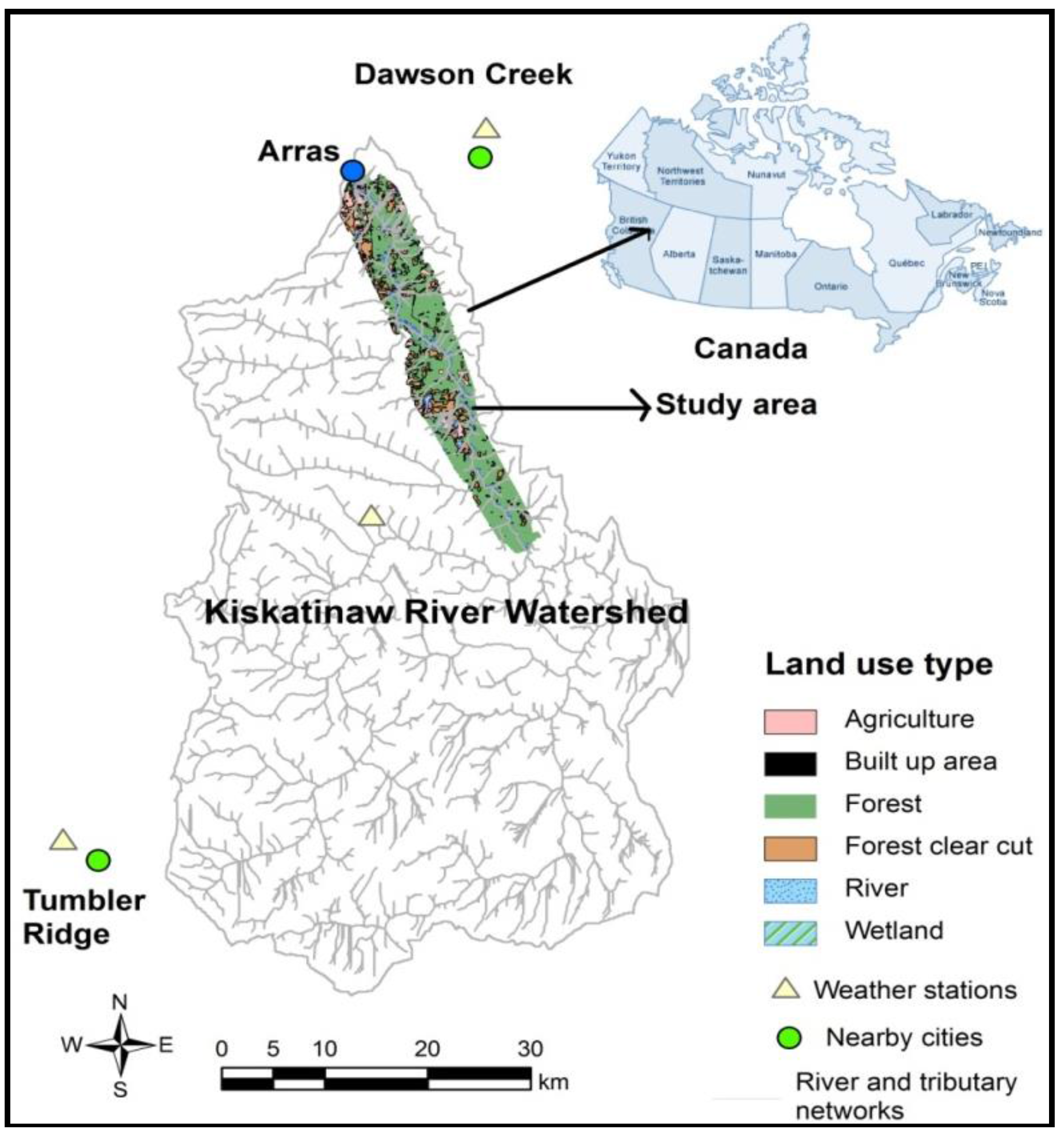
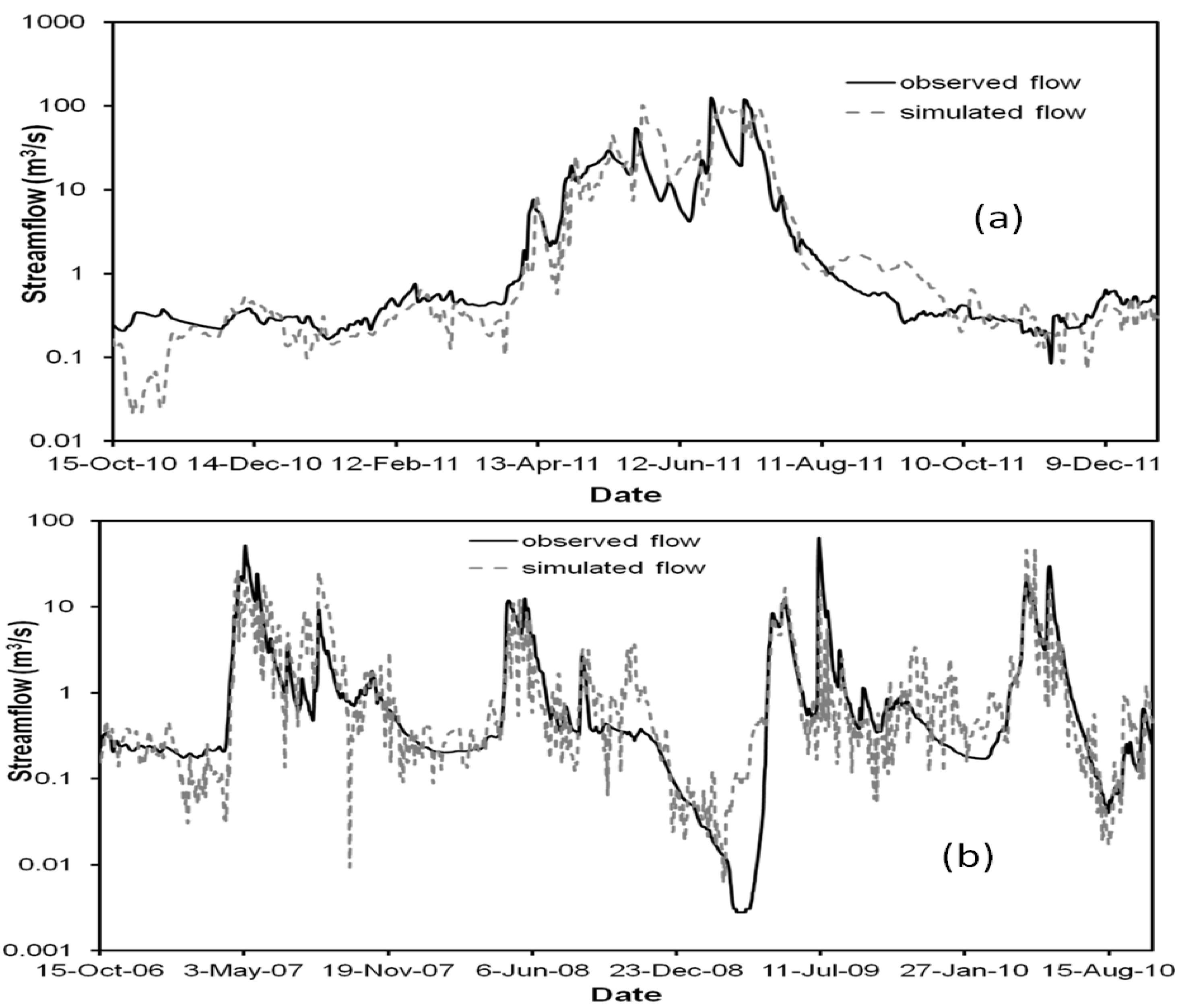
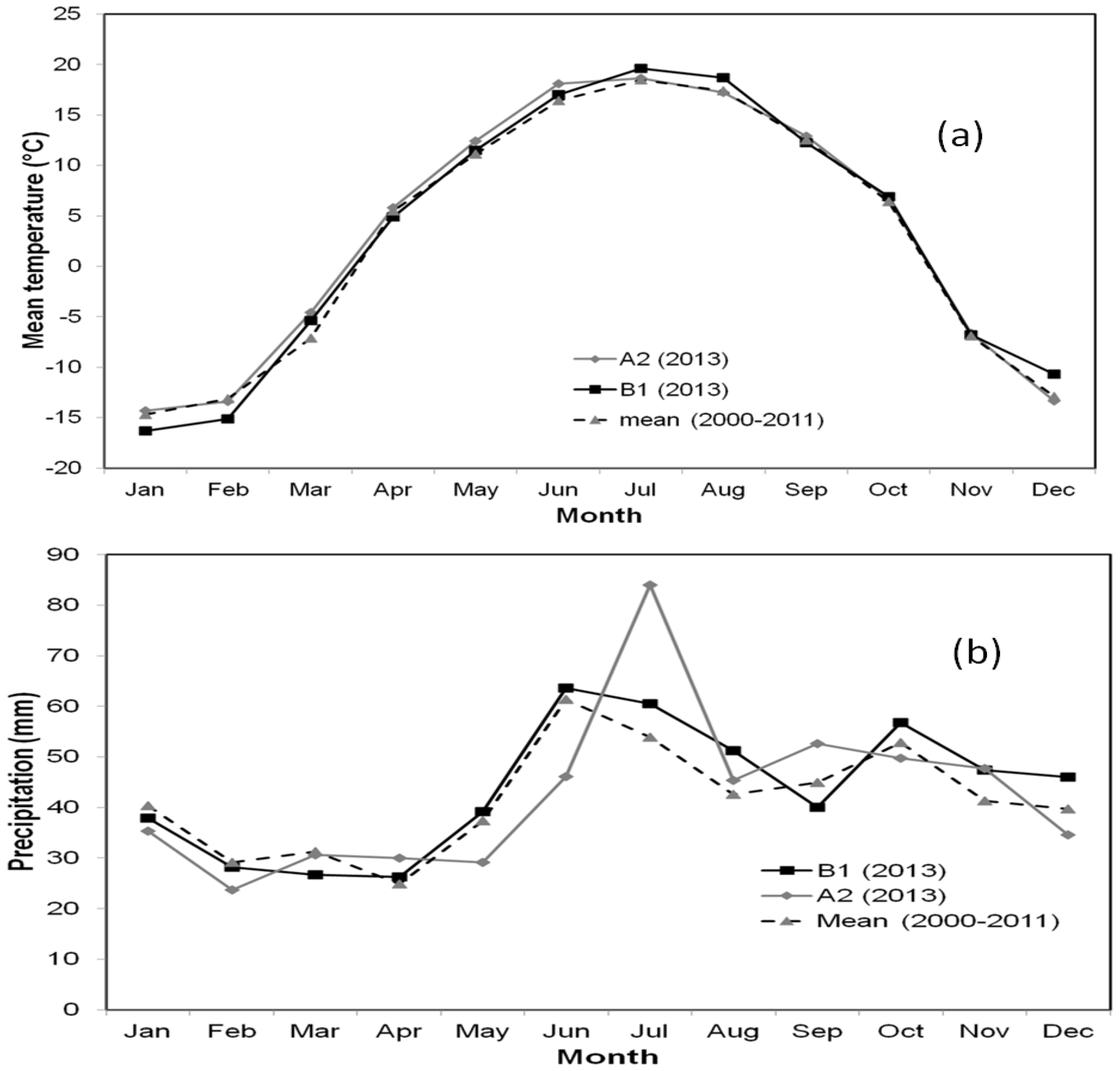
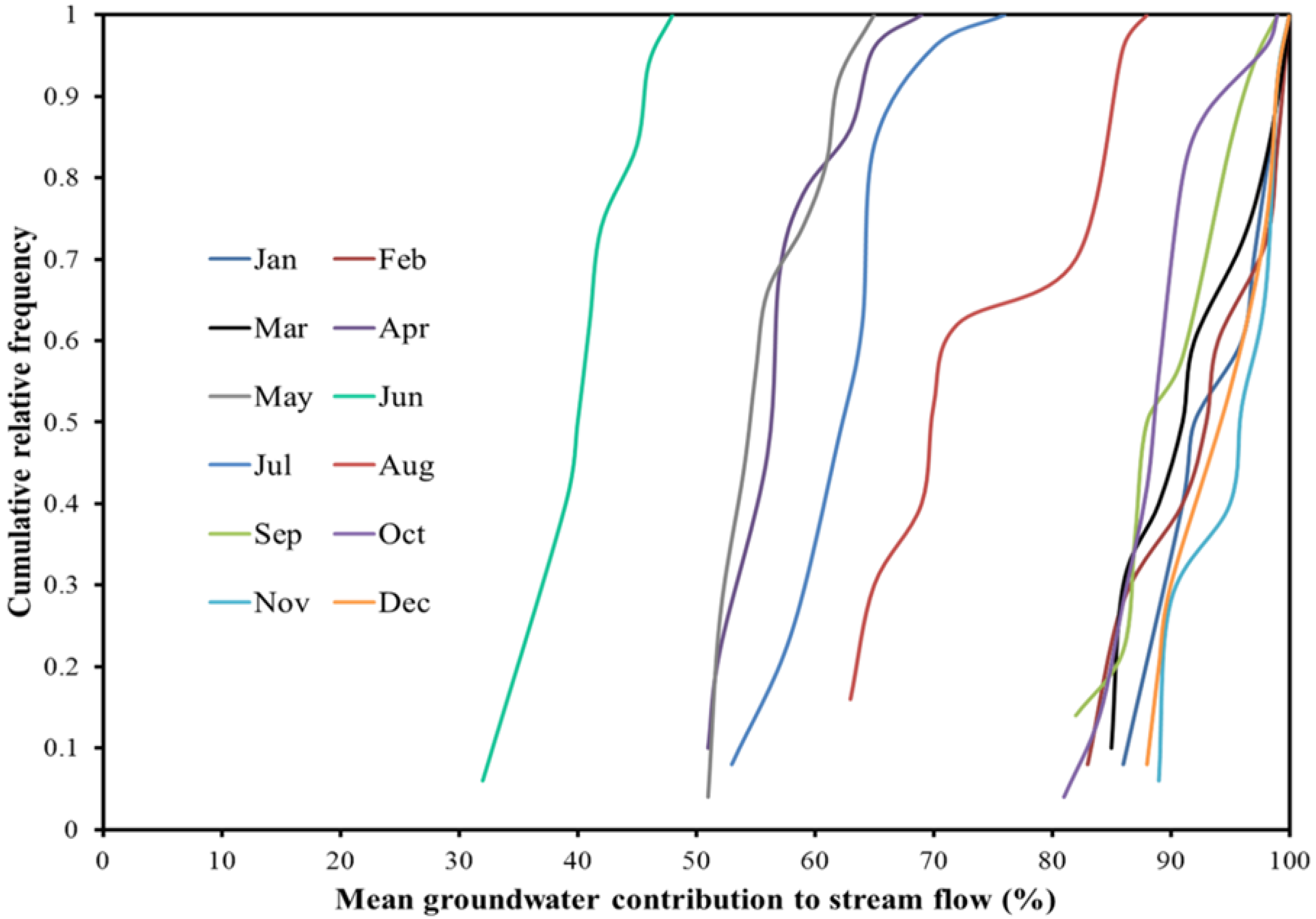
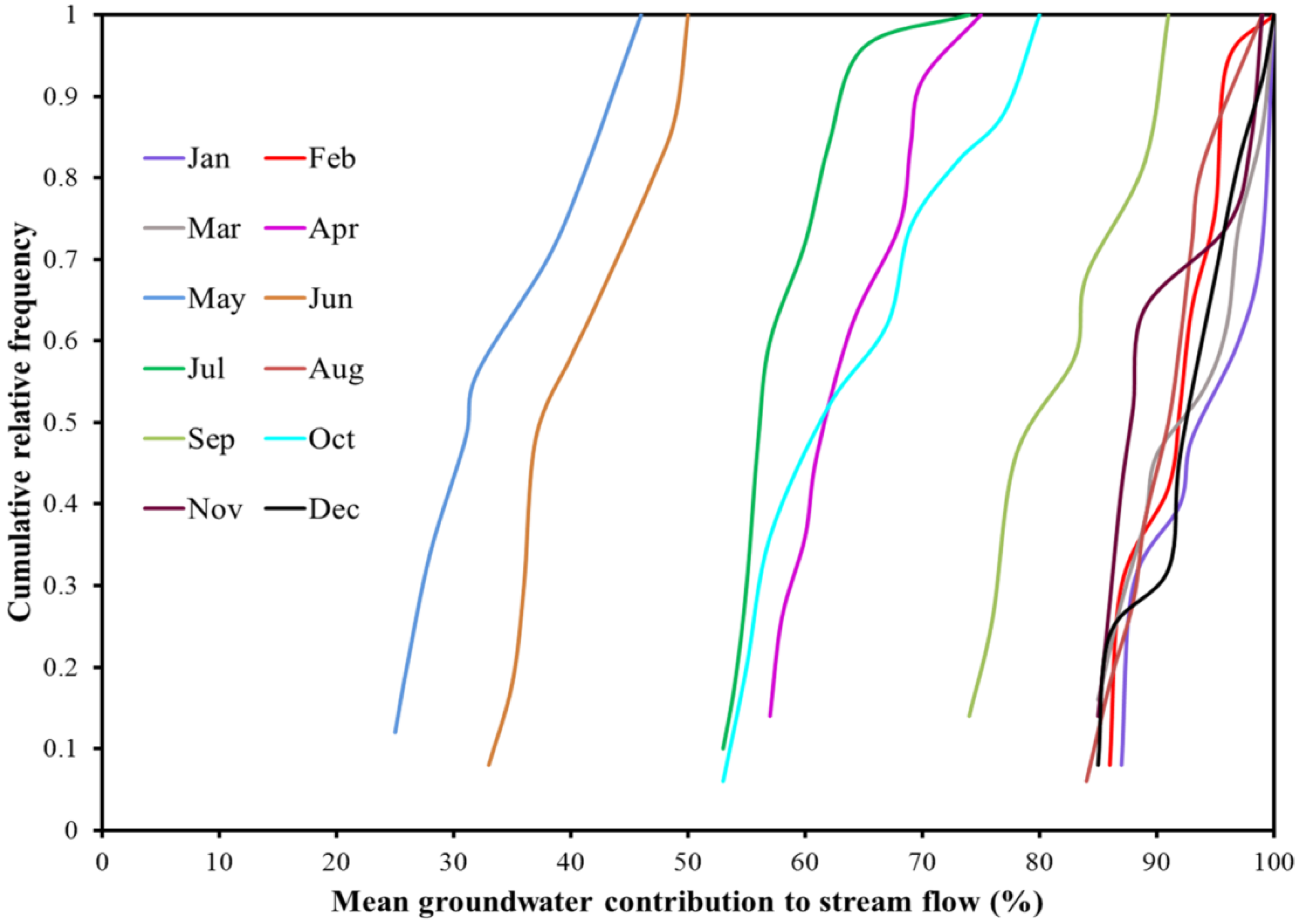
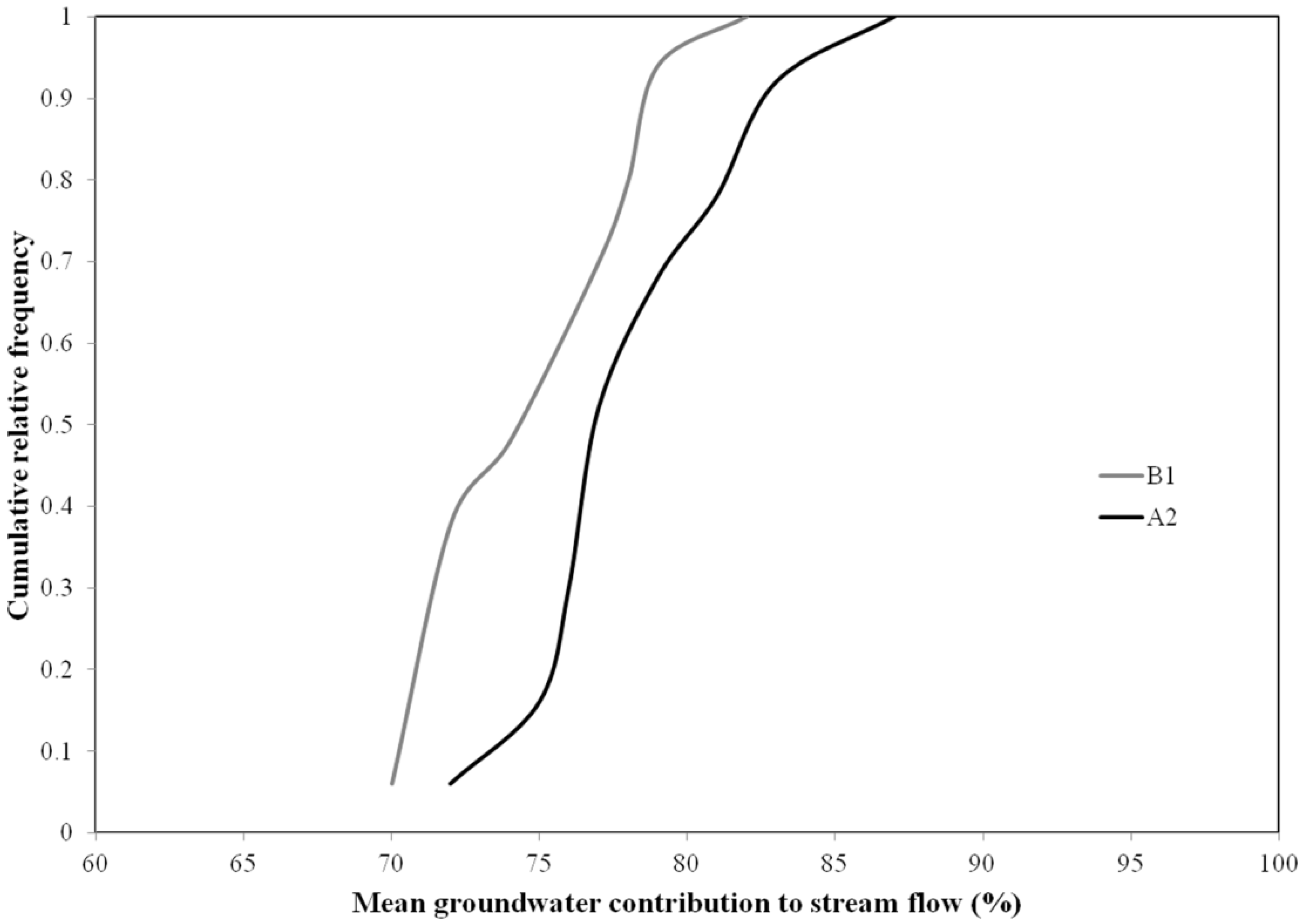
| Data Type | Data and Format | Source |
|---|---|---|
| Watershed |
| |
| Hydrological |
|
|
| Climate and Meteorological |
|
|
| Process | Process Parameter | Unit | Value |
|---|---|---|---|
| Infiltration and GW | Saturated hydraulic conductivity (Ks) (clay loam-forest) | cm/hr | 0.15 |
| Infiltration and GW | Ks (clay loam-built-up area) | cm/hr | 0.03 |
| Infiltration and GW | Ks (clay loam-forest clear cut area) | cm/hr | 0.08 |
| Infiltration and GW | Ks (clay loam-agriculture) | cm/hr | 0.10 |
| Infiltration and GW | Ks (clay loam-wetland) | cm/hr | 0.05 |
| Infiltration and GW | Ks (sandy loam-forest) | cm/hr | 0.93 |
| Infiltration and GW | Ks (sandy loam-forest clear cut area) | cm/hr | 0.34 |
| Infiltration and GW | Ks (sandy loam-agriculture) | cm/hr | 0.42 |
| Infiltration and GW | Ks (silt loam-forest clear cut area) | cm/hr | 0.7 |
| Infiltration and GW | Ks (silt loam-forest) | cm/hr | 0.81 |
| Infiltration and GW | Ks (silt loam-built-up area) | cm/hr | 0.09 |
| Infiltration | Initial moisture (clay loam) | - | 0.21 |
| Infiltration | Initial moisture (silt loam) | - | 0.15 |
| Infiltration | Initial moisture (sandy loam) | - | 0.11 |
| Overland flow | Manning’s n (built-up area) | - | 0.011 |
| Overland flow | Manning’s n (agriculture) | - | 0.035 |
| Overland flow | Manning’s n (forest) | - | 0.1 |
| Overland flow | Manning’s n (forest clear cut area) | - | 0.03 |
| Infiltration and GW | Porosity (silt loam) | - | 0.501 |
| Infiltration and GW | Porosity (clay loam) | - | 0.464 |
| Infiltration and GW | Porosity (sandy loam) | - | 0.453 |
| Channel flow | Manning’s n (river) | - | 0.025 |
| Soil moisture | Soil moisture depth | m | 0.5 |
| GW-stream | Ks (stream bed material) | cm/hr | 1.1 |
| GW-stream | Stream bed material’s thickness | cm | 15 |
| Retention | Retention depth (agriculture) | mm | 0.1 |
| Retention | Retention depth (forest) | mm | 0.12 |
| Retention | Retention depth (forest clear cut area) | mm | 0.1 |
| Parameter | Unit | Relative Sensitivity | Rank |
|---|---|---|---|
| Manning’s n (river) | - | 0.39 | 1 |
| Soil moisture depth | m | 0.32 | 2 |
| Initial soil moisture (clay loam) | - | 0.29 | 3 |
| Ks (clay loam-forest) | cm/hr | 0.24 | 4 |
| Porosity (clay loam) | - | 0.12 | 5 |
| Ks (clay loam-forest clear cut area) | cm/hr | 0.08 | 6 |
| Ks (clay loam-agriculture) | cm/hr | 0.006 | 7 |
| Ks (sandy loam-forest) | cm/hr | 0.0052 | 8 |
| Ks (clay loam-built up area) | cm/hr | 0.005 | 9 |
| Ks (clay loam-wetland) | cm/hr | 0.003 | 10 |
| Porosity (silt loam) | - | 0.002 | 11 |
| Ks (silt loam-forest) | cm/hr | 0.0001 | 12 |
| Parameter | Unit | Mean | Standard Deviation |
|---|---|---|---|
| Manning’s n (river) | - | 0.032 | 0.01 |
| Soil moisture depth | m | 0.60 | 0.125 |
| Initial soil moisture (clay loam) | - | 0.18 | 0.04 |
| Ks (clay loam-forest) | cm/hr | 0.20 | 0.08 |
| Porosity (clay loam) | - | 0.45 | 0.02 |
| Ks (clay loam-forest clear cut area) | cm/hr | 0.12 | 0.05 |
| Month | Range of Mean Groundwater Contribution to Stream Flow (%) | Mean (%) | Standard Deviation (%) | Output Using the Calibrated Parameters’ Values (%) |
|---|---|---|---|---|
| January | 86–100 | 94.19 | 5.74 | 93.16 |
| February | 83–100 | 93.22 | 6.32 | 90.79 |
| March | 85–100 | 92.44 | 5.63 | 93.53 |
| April | 51–69 | 58.19 | 6.08 | 54.26 |
| May | 51–65 | 56.78 | 4.71 | 57.23 |
| June | 32–48 | 41.10 | 4.45 | 44.04 |
| July | 53–76 | 64.40 | 5.55 | 59.20 |
| August | 63–88 | 76.76 | 10.01 | 71.89 |
| September | 82–99 | 90.41 | 6.33 | 88.94 |
| October | 81–99 | 90.06 | 5.53 | 93.81 |
| November | 89–99 | 94.73 | 4.35 | 95.90 |
| December | 88–100 | 95.23 | 4.55 | 97.50 |
| Month | Range of Mean Groundwater Contribution to Stream Flow (%) | Mean (%) | Standard Deviation (%) | Output Using the Calibrated Parameters’ Values (%) |
|---|---|---|---|---|
| January | 87–100 | 94.29 | 5.56 | 99.79 |
| February | 86–100 | 93.53 | 4.94 | 98.32 |
| March | 85–100 | 93.27 | 5.82 | 98.46 |
| April | 57–75 | 64.15 | 6.35 | 63.16 |
| May | 25–46 | 35.67 | 7.97 | 28.30 |
| June | 33–50 | 41.35 | 6.36 | 47.21 |
| July | 53–74 | 60.53 | 6.43 | 61.30 |
| August | 84–99 | 91.64 | 5.19 | 96.20 |
| September | 74–91 | 81.99 | 6.91 | 87.70 |
| October | 53–80 | 66.02 | 10.10 | 56.48 |
| November | 85–99 | 91.15 | 5.49 | 87.82 |
| December | 85–100 | 92.65 | 5.64 | 97.89 |
© 2017 by the authors. Licensee MDPI, Basel, Switzerland. This article is an open access article distributed under the terms and conditions of the Creative Commons Attribution (CC BY) license (http://creativecommons.org/licenses/by/4.0/).
Share and Cite
Saha, G.C.; Li, J.; Thring, R.W. Understanding the Effects of Parameter Uncertainty on Temporal Dynamics of Groundwater-Surface Water Interaction. Hydrology 2017, 4, 28. https://doi.org/10.3390/hydrology4020028
Saha GC, Li J, Thring RW. Understanding the Effects of Parameter Uncertainty on Temporal Dynamics of Groundwater-Surface Water Interaction. Hydrology. 2017; 4(2):28. https://doi.org/10.3390/hydrology4020028
Chicago/Turabian StyleSaha, Gopal Chandra, Jianbing Li, and Ronald W. Thring. 2017. "Understanding the Effects of Parameter Uncertainty on Temporal Dynamics of Groundwater-Surface Water Interaction" Hydrology 4, no. 2: 28. https://doi.org/10.3390/hydrology4020028





